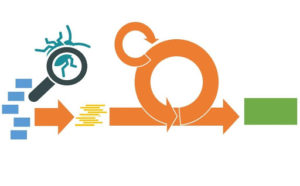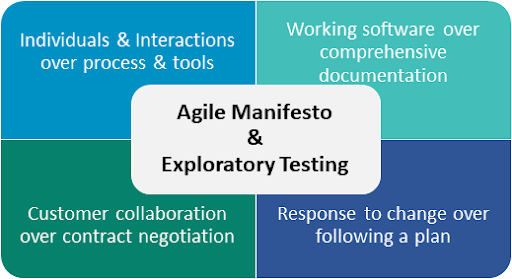
The software development and testing process have undergone multiple facelifts in the past few decades. The market demand and customer expectation to have a user friendly, feature-rich, fast processing, and secured software, drives the need to have a thorough testing process in place.
An agile methodology is a customer-centric approach that delivers a high-quality product in a short period of time. It is a fast, adaptable, and efficient approach that facilitates the early detection of bugs, thereby reducing the cost and efforts by fixing them early in the development cycle.
Exploratory testing is a hands-on approach in which testers are involved in minimum planning and maximum test execution. It involves simultaneous learning by discovery. The testers explore the application and learn about its functionalities by discovery and learning method. However, the tester has to adhere to the exploratory charter that has goals and boundaries for testing defined. For example, one vector to consider in the exploratory test could be focused on new or modified features, since every code change raises the possibility to introduce bugs. Another vector can be a complex module that is an unstable or buggy module of the product.

The shared value system of the Agile Manifesto
The Agile development model is iterative and incremental. The agile approach in Software Development revolves around collaboration, transparency, flexibility, and responsiveness to feedback throughout the software development life-cycle.
Exploratory testing shares the same fundamental value system of the Agile Manifesto.

The next few sections will elaborate more on this relationship.

Software is released iteratively in agile methodology. Frequent releases call for the comprehensive testing procedures and test automation for quick feedback and bug resolutions. Exploratory testing proves to be an efficient testing instrument since it is a hands-on time-boxed approach, in which testers are involved in minimum test planning and maximum test execution. It provides the fluidity and freedom to test any functionality without the need of much documentation. The speed of test cycles is improved because testers are not required to spend time in planning and writing the test cases. They can test the software and provide quick and actionable feedback.

It is important to have a well-rounded testing strategy in place for agile development. At the end of every cycle, test automation can find and report any regression issues for the added/modified/upgraded functionalities. Also, there may be certain scenarios where manual testing is performed by the testers. It could be either comprehensive or ad-hoc, depending on the type and criticality of the module being tested. Exploratory testing adds another dimension by testing the new features as one of the vectors for the testing. There might be some cases when there is a time crunch. In those cases, exploratory testing steps in, since it involves simultaneous learning by discovery. Of course, the testers have to adhere to the objectives and follow the workflow sequence while testing. This way it complements the test automation and manual testing very well.

Due to its inherent unstructured and freestyle nature, exploratory testing can reach the places where automation or test case based approaches may fall short in the frequent test cycles. Since it is managed using test charters and is time-bound, it becomes an excellent tool to mitigate risks within the stipulated time frame. In exploratory testing, the tester needs to identify the potential high-risk areas which are susceptible to bugs. The idea is to find and plug the possibilities that may lead to malfunctioning or crashing of the application.

While test automation takes care of most of the regression issues during the sprints, there could be some hidden bugs that may inadvertently escape the net of testing. Automation follows a predefined script and there are chances that a hidden bug, which may not fall in the script’s scope, is not unearthed during testing. Exploratory testing lends a hand in finding those bugs, thus minimizing the impact and maximizing the benefits.

The agile approach is customer-centric. The goal is to deliver a robust, secure, and functioning end product. Introducing exploratory testing in the test cycles adds the dimension of getting creative with testing. The testers can look beyond the routine process and comb through the software for any malfunctioning parts.

In case a bug is discovered during exploratory testing, it has to be properly documented for future references and corrections. These bugs can then be used to build a powerful test management system. Testers from varied backgrounds can add an element of diversity in exploratory testing, which further helps in discovering different bugs than usual. These new-found bugs can then be categorized and be used for writing advanced test cases. These test cases can then be automated for further test cycles. This not only adds diversity to testing but also improves the whole testing process in an agile approach.

Exploratory testing is definitely an asset to the agile process. When the agile methodology is complemented with exploratory testing along with test cases based defined testing, the whole testing ecosystem benefits. Leveraging the strengths of exploratory testing can aid in having a comprehensive test strategy in place and also empowers the agile teams to keep up with the pace of release cycles. It attaches priority to people’s thinking and analytical skill over the process and ensures timely response in case of any unforeseen situation.
Webomates offers regression testing as a service that is a combination of test cases based testing and exploratory testing. Test cases based testing establishes a baseline and uses a multi-execution channel approach, to reach true pass / true fail, using AI Automation, automation, manual and crowdsource. Exploratory testing expands the scope of the test to take the quality to the next level. Service is guaranteed to do both and even covers updating test cases of modified features during execution in 24 hours.
At Webomates, we continuously work to evolve our platform & processes in order to provide guaranteed execution, which takes testing experience to an entirely different level, thus ensuring a higher degree of customer satisfaction.
If you are interested in learning more about Webomates’ CQ service please click here and schedule a demo, or reach out to us at info@webomates.com
Tags: Agile methodology, Exploratory testing, Regression Testing
Test Smarter, Not Harder: Get Your Free Trial Today!
Start Free Trial
Leave a Reply